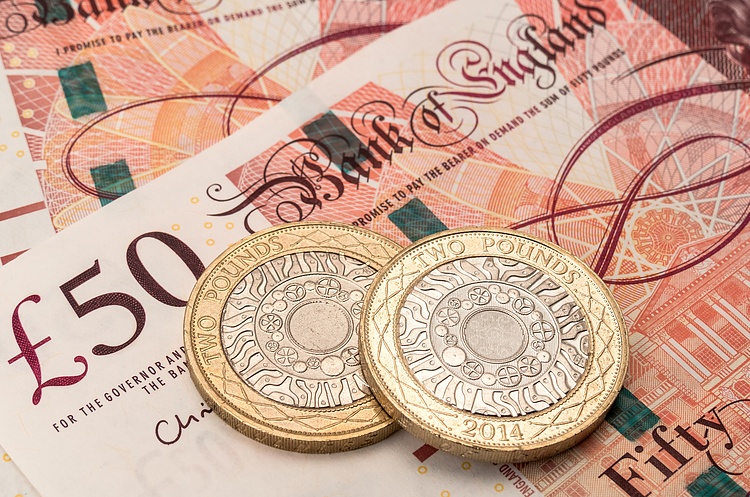The pound strengthened in a narrow range ahead of UK employment data.

- Pound Sterling trades back and forth as investors shift focus to UK employment data.
- Weak wage growth data will temper the inflation outlook and raise expectations of a rate cut by the BoE.
- Due to the extended weekend in the US markets, market volumes will still be modest.
Pound sterling (GBP) remains quiet as investors wait for UK labor market data for the three months to November to be released on Tuesday. Investors expect wage growth to fall sharply and labor market conditions to cool further due to a deepening cost-of-living crisis caused by interest rate hikes by the Bank of England and stubborn consumer inflation.
Lower wage growth data will improve the pace of inflation’s recovery towards 2% as lower incomes ultimately reduce households’ spending power. Stubbornly high wage growth remains a key factor driving sticky consumer price inflation, and falling inflation would provide greater relief to BoE policymakers.
With US markets closed on Monday, the GBP/USD pair is likely to remain volatile. Trading volume is expected to be minimal due to the weekend holiday. However, continued bets on a rate cut by the Federal Reserve (Fed) at its March monetary policy meeting will likely push the US Dollar Index (DXY) back.
Daily Digest Market Movers: The pound remains flat in closed US markets.
- Pound sterling is struggling for a decisive move as investors await UK labor market data for the three months to November to be released on Tuesday.
- Labor demand is expected to remain weak, as job postings by UK employers fell 32% in December compared to the previous year. The Department for Recruitment and Employment (REC) said full-time jobs fell throughout 2023.
- Investors expected the unemployment rate to rise slightly to 4.3% from the previous figure of 4.2%.
- Market participants will focus on average earnings data as robust wage growth remains a key driver of higher consumer price inflation in the UK economy.
- Average earnings excluding bonuses are expected to slow sharply to 6.6% compared to growth of 7.3% in the October quarter, while earnings data including bonuses are expected to slow to 6.8% from 7.2% in the comparable period.
- A sharp decline in wage growth would reduce concerns about persistent inflation and increase the likelihood of an early interest rate cut by the Bank of England.
- Bank of America (BofA) predicts that the BoE will consider cutting interest rates after its August monetary policy meeting. This contrasts with previous projections of February 2025.
- Conversely, BoE policymakers have not publicly discussed interest rate cuts, as consumer price inflation in the UK economy is the highest compared to other G7 economies.
- BoE policymakers have repeatedly emphasized the need to keep interest rates on a high trajectory to ensure inflation returns to 2% in a sustainable manner.
- The UK property sector is off to a decent start to 2024 after a weak 2023. Rightmove, the UK’s leading property platform, reported a 1.3% increase in asking prices between December 3 and January 6, the highest since 2020.
- The market atmosphere in the US market is quiet as the weekend has been extended due to Martin Luther King Day.
- The US Dollar Index (DXY) trades back and forth around 102.40 as investors focus on monthly retail sales data and the Federal Reserve’s (Fed) Beige Book release on Wednesday.
- Meanwhile, investor confidence in the Federal Reserve’s decision to cut interest rates in March improved following the release of the weaker-than-expected producer price index (PPI) report in December.
- The likelihood of support for a March rate cut has risen to 70%, after falling to 62% last week, according to the CME FedWatch tool.
Technical Analysis: Pound Sterling consolidates above 1.2700.
Pound sterling trades listlessly above crucial support at 1.2700 as investors await important UK data for further action. The GBP/USD pair has fluctuated between 1.2674-1.2784 over the past week. The broader appeal remains bullish as the 20-day and 50-day exponential moving averages (EMAs) are sloping higher. The 14-day Relative Strength Index (RSI) fluctuates in the range of 40.00-60.00, indicating consolidation ahead. A new uptrend is expected if cable breaks above the five-month high near 1.2820.
Pound Sterling FAQs
Pound sterling (GBP) is the world’s oldest currency (886 AD) and the official currency of the United Kingdom. According to 2022 data, it is the fourth most traded foreign exchange (FX) unit in the world, accounting for 12% of all transactions, averaging $630 billion per day.
The main trading pairs are GBP/USD and EUR/GBP (2%), also called FX, GBP/JPY or ‘Cable’, which accounts for 11% of the ‘Dragon’ (3%) as it is known to traders. . Pound sterling is issued by the Bank of England (BoE).
The most important factor affecting the value of the pound sterling is the monetary policy determined by the Bank of England. The BoE bases its decision on whether it has achieved its main goal of “price stability” – a steady inflation rate of about 2%. The main tool to achieve this is interest rate adjustments.
If inflation is too high, the BoE will try to curb it by raising interest rates, which will make it more expensive for individuals and businesses to get credit. This is generally positive for GBP. This is because high interest rates make the UK a more attractive place for global investors to invest their money.
When inflation falls too low, it is a sign that economic growth is slowing. In this scenario, the BoE would consider lowering interest rates to ease credit so businesses can borrow more to invest in growth projects.
The data release measures the health of the economy and could have an impact on the value of the pound. Indicators such as GDP, manufacturing and services PMI, and employment can all influence the direction of GBP.
A strong economy is good for sterling. Not only would this attract more foreign investment, it could directly strengthen the GBP by encouraging the BoE to raise interest rates. Otherwise, if economic data is weak, the pound is likely to fall.
Another important data release for the pound sterling is the balance of trade. This indicator measures the difference between the amount a country earned from exports and the amount it spent on imports during a specific period.
When a country produces export goods that are in high demand, its currency benefits purely from the additional demand created by foreign buyers willing to buy those goods. Therefore, a positive net trade balance strengthens the currency, while a negative net trade balance strengthens the currency.
Source: https://www.fxstreet.com/news/pound-sterling-turns-sideways-ahead-of-uk-labor-market-data-202401150828



